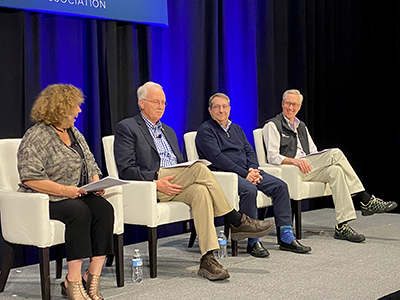
#MBACMST23: Learn from the Downturns

(l.-r.: Bonnie Yvette Hochman Rothell, Daniel Phelan, CMB, CRI, CCMS, Alan Kronovet Jr., CCMS, Dan Olsen, CCMS)
CHICAGO–Real estate has always been a cyclical industry, so we can learn a lot from past downturns, panelists noted here at the MBA Commercial/Multifamily Finance Servicing and Technology Conference.
For example, Dan Olsen, CCMS, Senior Vice President with KeyBank Real Estate Capital, Cleveland, said nearly one-third of all savings and loan institutions failed during the savings and loan crisis of the 1980s and early 1990s. But he noted this crisis led directly to the creation of commercial mortgage-backed securities.
“I’m not sure we would be in this room without the S&L crisis,” Olsen said. “The CMBS industry is basically an offspring from the S&L crisis. That crisis was caused by bank lending fraud and appraisal fraud. People went to jail for it. They were re-appraising real estate again and again, ending up with inflated values for S&Ls and banks and the rest of the industry. It was flat-out fraud. It ended up with a commercial real estate bubble.”
Olsen said capital was extremely hard to find in the early 1990s. “There was a capital crisis,” he said. “Then CMBS came to the rescue in 1994 and 1995.”
Alan Kronovet Jr., CCMS, Head of Commercial Mortgage Servicing with Wells Fargo Bank, Charlotte, N.C., praised trade associations such as MBA that worked with the Federal Reserve Bank of New York during the S&L crisis.
“What brought back the securitization industry is the New York Fed saying ‘we are going to back the senior bonds; we’ll create more structure, create new oversite and make it a little bit tighter,’” Kronovet said. “That created and improved the CMBS industry we see today. If it wasn’t for groups like the MBA working with the New York Fed, the CMBS industry would not have been revived.”
Daniel Phelan, CMB, CRI, CCMS, Chief Executive Officer of Pacific Southwest Realty Services, Los Angeles, noted the CMBS industry brought greater discipline and transparency to commercial real estate finance. “CMBS actually solved a lot of issues that allowed us to find new sources of capital,” he said. “CMBS brought the standardization of documentation and reporting that we live by today.”
Kronovet said the Sept. 11, 2001 attacks caused another economic downturn. “There’s been nothing like that since Pearl Harbor,” he said. “Then in 2008 we had the Global Financial Crisis. The real pain then was on large assets. There were losses, but it worked itself out. The Global Financial Crisis was bad on the commercial side, but it was much worse on the residential side. That was a leverage issue, not necessarily a credit quality issue.”
Past financial crises have led to new legislation and regulation from Washington, Kronovet said. “For example, the S&L crisis led to a lot of new legislation including the Financial Institutions Reform, Recovery and Enforcement Act,” he said. “The Global Financial Crisis led to the Dodd-Frank Wall Street Reform and Consumer Protection Act and the 1929 Wall Street crash led to the Glass-Steagal Act of 1933.”
More recently, the COVID pandemic changed the world starting in early 2020. “When COVID hit, all offices closed nearly overnight, many companies suddenly had to figure out a technology solution for employees to work from home,” Phelan said. “In our shop, we hired someone to get us all connected so everybody could work from home. We had to learn a new way of doing business. Retail and restaurants were suddenly out of business. This struck me: prior to COVID, when lenders would underwrite deals, they tended to want the national firms and big tenants. But after COVID hit, it was the small mom-and-pops that got creative. The big firms said ‘we are going to close,’ but the mom-and-pops said ‘we can’t close; this is our living.’ There was a lot of ingenuity that went to solving this.”
Kronovet noted mortgage servicers left work on a Friday in March 2020, “then by Monday they were all drinking from a fire hose while also working from home. It was really remarkable performance by the commercial real estate servicing industry in all aspects,” he said. “The demands were unlike demands seen in other crises. Everyone was in a panic. I never had so many calls from regulators and publications asking to talk about what’s going on in our portfolio and what we were seeing.”
